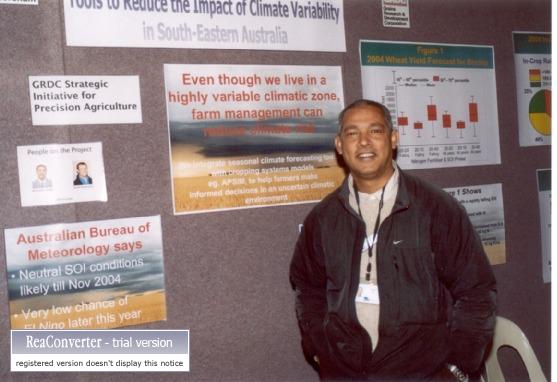|
Climate
Impacts for Farmers
Dr Muhuddin Rajin Anwar
Cropping System Modeller - Climate
Risk
Department of Primary Industries-VIDA, Victoria
I
am an agronomist (PhD. in Agriculture), currently
working as a “Cropping System Modeller–Climate Analyst” in
the Department of Primary Industries, Victoria, based at Horsham.

My family background is farming. Since childhood, I enjoyed
visiting farms and forests. Eventually,
I ended up doing botany science and finally agriculture in
university. This has enabled me to seek a career in agricultural
fields. I began in private industry, and
then moved to government departments and
took on several client services roles in developing as well
as in developed countries like India, New Zealand, Japan,
and now in Australia.
This position involves working extensively in an exploratory
study. I am doing basic and applied research in the
management of climate risks and efficiencies in agricultural
production systems associated with variations over time and
location in South Eastern Australia.
One of my current projects -- developing tools to reduce
the impact of climate variability in south eastern
Australia -- is in a final phase. We are initiating a complementary
collaboration, linking with "Facing the Challenge of
Climate Change - Impacts and Adaptation in Regional and Agricultural
Systems in Victoria" project.
In this connection, I was in Werribee DPI office from 10 April
2006. On 12 April, I started early (7.30 AM)
beginning with a discussion with Senior Research staff of
the Climate Change project.
By 8.30 AM, I started making input
parameter files to run crop simulation models on the computer.
In the midst of these input file parameterisation, I frequently
interacted with Werribee climate and soil staff for many clarification
of issues. Just before lunch, I completed a crop simulation
for one location based on historical climate data.
After a lunch break, I discussed
the simulated results and explored how this could be used
for climate change analysis. At 2.00 PM,
along with Werribee climate staff, we had a telephone conference
with CSIRO Marine and Atmospheric Research staff regarding
integration of a global atmospheric model,
developed by CSIRO, with crop simulation models.
After a tea-break, I continued organising
historical climate files and crop-soil parameters transect
through the Victorian grain belt (Wimmera, Mallee and High
Rainfall zones). At last, we discussed and prioritised objectives
of the simulation to quantify historic trends in key climate
factors, such as changes in temperature extremes, frost, and
rainfall, before finishing up for the day.
We want to do this work because the predominant view of climate
scientists is that an increase in greenhouse gas concentrations
will result in significant climate changes. In particular,
an increase in global temperature and changes in precipitation
are expected. These changes, which are likely to occur in
the coming decades, may have significant consequences (positive
and negative) on the development, growth, and yield of rainfed
crops in Southeastern Australia, having high economic importance
– specifically for wheat and chickpea.
CSIRO have developed climate change scenarios
(global warming values and CO2 concentrations
from the year 2000 to 2070). It fits in my career path to
do analysis of the crop-climate simulation to evaluate potential
shifts in agricultural practices that could reduce the potential
negative effects of climate change. That is, how might farmers
change what they plant in response to changing climate?
The main source of variability in the Victorian and Australian
economies is the fluctuation
in agricultural production related to climate variability.
About 40% of the temporal variation in the net value of the
grains and extensive grazing industries can be attributable
to climate risk, mainly rainfall related.
Despite the diversity of the Victorian farm sector, which
might be expected to dampen much of the broader impact of
extreme climatic events on its economy, Victorian primary
industries can still be severely and widely affected by droughts.
I would like to make an attempt to address some of these issues
by assessing the economic value for farmers of existing forecasting
systems and developing methods to incorporate climate information
into farm decision making.
|
|